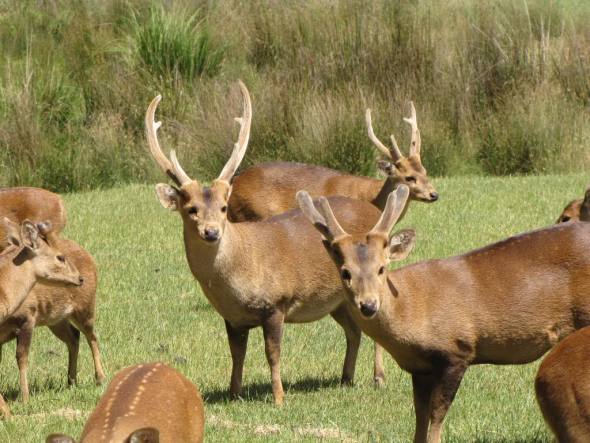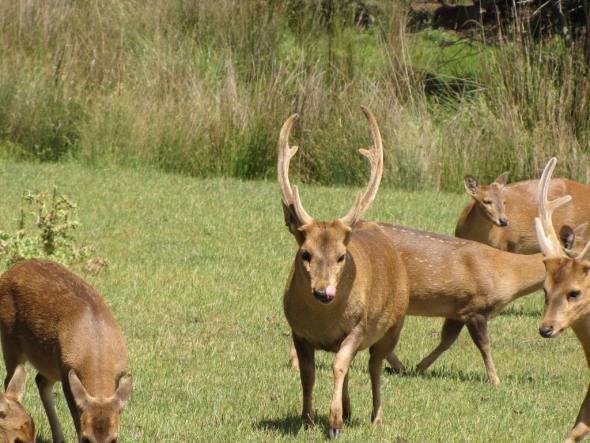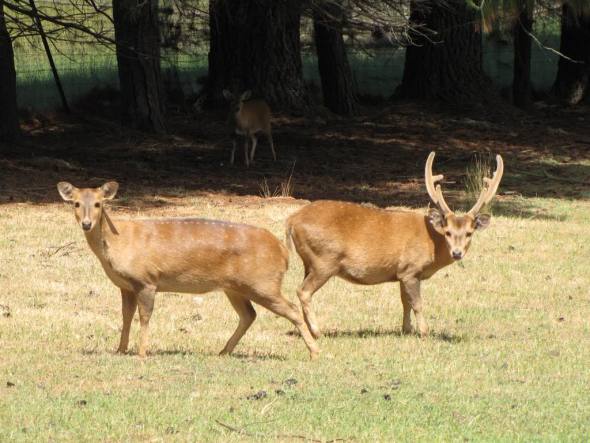Endangered Species Monday - Axis calamianensis
Endangered Species Monday - Axis calamianensis
This Mondays endangered species article we take a brief look into the secretive and rather elusive life of the Calamian Hog deer scientifically identified as - Axis calamianensis the species is also commonly known as the Calamanian Deer, Calamian Deer, Calamian Hog Deer or the Philippine Deer.
(Pictured above: Calamian Hog stag)
A. calamianensis was formally identified back in 1888 by Dr Pierre Marie Heude (1836–1902) was a French Jesuit missionary and zoologist. Born at Fougères in the Department of Ille-et-Vilaine, Heude became a Jesuit in 1856 and was ordained to the priesthood in 1867. He went to China in 1868. During the following years, he devoted all his time and energy to the studies of the natural history of Eastern Asia, traveling widely in China and other parts of Eastern Asia.
From 1986 - 1990 A. calamianensis was listed back then as vulnerable however, since this time much has changed regarding the species habitat, and way of living. From 1994 Dr Groombridge identified the need to re-list the species as (endangered) of which a further evaluation after a more in-depth census was concluded (1996) showed the species to be verging near extinction. The last “population census” undertaken in 1996 confirmed the species was still endangered, which led to evasive and aggressive conservation projects to be put into action to preserve the species.
Image: Calamian stag a little uneasy on his feet
Endemic to the Philippines the species is restricted to the Calamian Islands in the Palawan faunal region. The species occurs on three of the four larger islands of Calamians, i.e. Busuanga, Calauit and Culion. Sketchy reports have suggested the species also occurred on at least nine other related islands too however, little evidence backs these claims up.
Reports have confirmed that localized extinctions have occurred in some (78%) of these islands; (Bacbac, Capari, Panlaitan, Galoc, Apo, Alava and Dicabaito), and to survive on only two of these islands, namely Marily and Dimaquiat. A. calamianensis is not known to occur anywhere else from outside of its now fragmented ranges.
Commonly viewed within most of its native range back in the middle 1940’s population sizes have seriously diminished since the late 1990’s. While many drastic declines were seen throughout the 1990’s one area that didn’t see population declines was that of the extreme south of Culion, by the mid-1970s.
By the time the Calauit Island Game Preserve and Wildlife Sanctuary was created, in some way to preserve species populations, conservation actions were already to late of which populations had declined quite rapidly. Reports placed the population size from 1,900 “individuals” which equated to around 250 “mature individuals (if that).
Recent surveys from 2006 showed quite drastic declines of which hunting was yet again the main primary cause for the species nearing extinction (many hunters try to defend and debate this - yet the evidence is there in black and white for them all to view). Despite a negative outlook from the last “official” 2006 census populations were still said to be quite widespread in Calauit, Busuanga and Culion. The 2006 census conducted by environmentalists, Rico and Oliver also confirmed the species populations were quite dense on the islands of Marily and Dimaquiat.
The overall reports into present population sizes though is not good, and its with sad regret to report that populations are continuing to decline at a very rapid rate, despite the species coming under some protective plans there really is no real “protection or even law implemented into action” to protect this species for future generations to come. Listed on the Convention on International Trade of Endangered Species (Cites) Appendix I localized hunting for food continues to place the entire species in “great danger of nearing extinction” within the next five to seven years. However I must state that “should” extinctions occur in the wild, captive breeding programs are already in place in the hope to later reintroduce the species into a newer, and safer habitat.
Image: Doe and Stag
Current plans to preserve species are that of protective breeding programs for later reintroduction back into the wild. San Diego Zoological Gardens currently hosts some fifty four (54) inhabitants successfully bred within the zoo and managed well.
Threats
Currently research has proven the local people to hunt the species for food and use within dress and musical instrument production. Hunters within the species endemic island ranges are known to hunt the species for its antlers for use within the home as a decorative piece. Antlers are prized among the locals.
The species is threatened due to hunting pressure and human settlement and agricultural expansion over its very limited range, coupled by the evident lack of effective and sustained enforcement of the strong local protective legislation.
Hunting was particularly severe during the mid-1970s, but seemingly declined in most areas during the 1980’ and 1990’s, except on Calauit where hunting pressure increased dramatically following the resettlement of the island by former residents under the auspices of the ‘Balik (Back to) Calauit Movement’. In 1986, 51 out of the 256 families evicted from the island ten years earlier had re-settled on the island, and by 1992 the settlers numbered nearly 500 people.
Much of the hunting of the species is recreational, and also to provide venison to the local markets. On Calauit, introduced African ungulate populations are increasing but are probably not competing with Calamian deer. A presidential proclamation that precluded removal or control of exotic species, and the movement or management of Calamian deer on Calauit Island was recently amended, thereby also potentially enabling the better future control of the exotic ungulate populations, though in fact many of these populations have also been seriously reduced by poaching.
While relatively large parts of Busuanga and Culion Islands are still undeveloped and sparsely inhabited, there are no proper reserves on either.
The following conservation actions are in place or still under amendment:
1. Monitor current status on all the three islands and determine population trends. Evaluate levels of hunting and habitat loss.
2. Strengthen existing protected area system via establishment of new (additional) reserves and development and implementation of properly structured conservation management plan for Calauit that includes improved infrastructure, and measures to combat poaching.
3. Agree and establish a zoning system within Calauit in collaboration with all relevant stakeholders, which enforces strict protection of the core area.
4. Establish protected areas on Culion and Busuanga, based on habitat and deer status surveys.
5. Undertake behavioral and ecological research of Calauit deer to determine management requirements. Conduct
more detailed studies in selected areas.
6. Initiate a conservation education program using Calamian deer as a flagship species to promote a wide variety of related conservation activities, including combating the bush meat trade.
Unfortunately due to the species being so rare there remains very little video data on the animal. Below and included for your information depicts a captive breeding program, and not a public zoological garden. Captive breeding programs in most cases forbid the public from entry. Children can be heard in the background however we must note, protective breeding programs are out of public site. Images above include other species of red and velvet deer too. As explained due to such rarity of this animal obtaining any real positive data of the animal has proved at the best of times difficult. Please contact myself below for further information or questions.
Thank you for reading
Dr Jose C. Depre.





